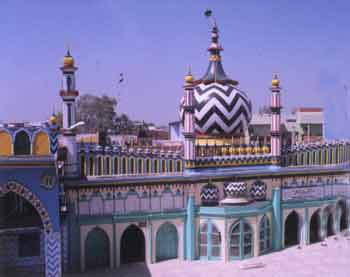In the year 1286/ 1869, Imám Raza was a qualified Muslim scholar at the age of only thirteen years and was also at the same time given the responsibility of Mufti by his father Hazrat Naqi Ali Khan and he served the religion for fifty-four years of his life until 1340/1921.
It is said that upon the return of pilgrimages from Hajj, they would come to visit Imám Raza upon which Imam Raza would ask, 'Did you visit the court of the Holy Prophet (sallaláho alaihi wassalam)?', if they replied in the positive, the great Imám would leap to kiss their feet and if they replied in the negative he would not pay any attention to them.
Imám Raza also looked after the poor and needy. Monthly allowances were sent to widows and the disadvantaged and these charitable services were not restricted to the locals but were sent in the form of money orders via the post. He would not advertise his charitable works nor did he give openly to shame those in need. He did not do all this for personal benefit or fame but to gain favour of Allah and His Prophet.
Imam Raza would wear new clothes twice a week, once on Friday and the other on a Tuesday. He would also wear new clothes for special occasions like the two Eids (i.e. Eid-ul-Fitr or Eid-ul-Adha) and the Birthday of the Prophet Muhammad (sallaláho alaihi wassalam) regardless of the day they fell upon according to the Lunar calendar.
His love for the Holy Prophet was so such that when he would go to sleep he would sleep positioning his blessed self in the shape of the name of the Holy Prophet Muhammad as it is spelt in the Arabic language. He would sleep moulding his both hands together under his head and he would join his feet together, making his head into the shape of the Arabic letter 'Meem', and his elbows would be shaped as the 'Ha', and his waist as the second 'Meen', and the the feet would serve as the letter 'Dhaal.'
He would never place another book on top of a book of Ahadíth and during the translation of a hadith if anyone would intevene Imam Raza would be upset with such a person due to his utmost respect for the words of the Holy Prophet. During the recitation of the events of the birth of the Holy Prophet at a Milad-ul-Nabi gathering, he would stand in respect and during the rest of the gatherings he would set respectfully on his knees showing respect to all forms of the Prophets remembrance.
He would never laugh loudly and upon yawning he would place a finger between his teeth, this would stop the sound made upon yawning. He would never spit facing towards the Qiblá nor would he lengthen his legs in the same direction. He also disliked the use of súf (a piece of cloth dropped in the ink pot to help proper inking of the pen) and also disliked the use of a pen made from iron.
Most of his time would be taken up in writing and reading, research, writing Islamic edicts (Fatáwas) and teaching. He would promptly worship in the mosque for all five daily prayers in congregation. He was temperamentally ardent. He would always wear a turban and a long coat while praying saláh, especially for the obligatory prayers (fará'idh) for which he would never just pray with a hat and a kurta (South Asian men's long shirt). He would usually perform his wudhu at home but in case he needed to perform it in the mosque for whatever reason, he would use a container (lautá) made from clay go to the far north side of the mosque. Imam Raza was very careful upon performing his wudhu (ritual cleansing) and ghusl (ritual bathing) for which two water pots would be placed for his wudhu. He would normally go home after the congregational prayers except for the Asr prayer, after which chairs would be placed all around for visitors and those in need of spiritual counselling or otherwise. If the Imam was giving something to a person and if he put his left hand to receive it, Imam Raza would immediately stop his hand and would say, 'take with your right hand for Satan takes with the left hand.' The numerical value of the Basmallah totals up to 786 and people generally write 786 beginning from the left with the number seven but Imam Raza would always begin writing from the number six, thus starting to write with the right side even when writing numbers.
skip to main |
skip to sidebar

The famous Muslim revilalist of traditional Sunni Islam of the Sub-Continent of India from (1856-1921). A whole movment of Sunni revival was centered around the most eminent personality of the 20th century, Imam Raza, who defended the honour of the Prophet of Islam against modernists and reformist Wahhabi movements in India.
The final resting place of Imam Ahmad Raza Khan
